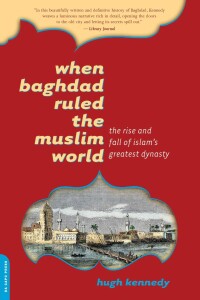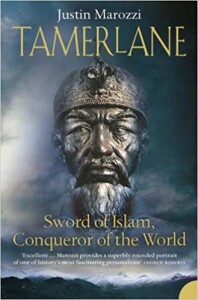 Da Capo Press has been a member of the Perseus Book Group since 1999. World history is one of its specialty lines and probably the category in which I would place both of these titles. At least in my experience with Da Capo, they often pick up the world distribution rights to titles that have already been published in the UK. This is certainly the case with both of these titles. When Baghdad Ruled the Muslim World: The Rise and Fall of Islam’s Greatest Dynasty was originally published in 2004 as The Court of the Caliphs by Weidenfeld & Nicholson, an imprint of the Orion Publishing Group. The UK edition of Tamerlane: Sword of Islam, Conqueror of the WorldTamerlane in one of the remainder catalogs for a price so low I cringed. How quickly, how cruelly, these works fall from grace!
Da Capo Press has been a member of the Perseus Book Group since 1999. World history is one of its specialty lines and probably the category in which I would place both of these titles. At least in my experience with Da Capo, they often pick up the world distribution rights to titles that have already been published in the UK. This is certainly the case with both of these titles. When Baghdad Ruled the Muslim World: The Rise and Fall of Islam’s Greatest Dynasty was originally published in 2004 as The Court of the Caliphs by Weidenfeld & Nicholson, an imprint of the Orion Publishing Group. The UK edition of Tamerlane: Sword of Islam, Conqueror of the WorldTamerlane in one of the remainder catalogs for a price so low I cringed. How quickly, how cruelly, these works fall from grace!
I decided to review these books together because of their common themes of cultural and territorial conquest in roughly the same geographic area, as well as because they arrived in the same package!
Hugh Kennedy is a professor of Middle Eastern History at the University of St. Andrews in Edinburgh. He’s written quite a few other books about topics related to the spread of Islam and the efforts of other groups (e.g., the Mongols, Huns and the Vikings) to conquer territories and peoples. Islam’s greatest dynasty is otherwise known as the Abbasid Caliphate. Caliph is an honorific title, meaning Deputy of God; the modifier Abbasid refers to the dynasty’s founder, Abbas, uncle of the prophet Muhammad. Among the members of this illustrious family is Harun al-Rashid, one of the few historical figures to appear in the Arabian Nights. The term Abbasid Caliphate appears to refer to the ruling family, which lasted for over two hundred years, from 749 to around 935 CE; to the territory they held, which extended from Egypt in the west to the borders of India and China in the east; and to the unified Islamic culture they promoted and enforced.
It’s hard to imagine how anyone could tell this long and complex story in just under three hundred pages of text. The explanation is really quite straightforward: the persons lived and the events took place long, long ago, in a land far, far away, at a time when historical record-keeping was not very well established as a practice. As a consequence, many of the stories about the members of this family read like tales from the Arabian Nights. Kennedy often includes multiple versions of the same story, which is simultaneously enlightening (in reminding the reader that history depends on point of view) and confusing, in the way that alternative tellings can be confusing. His narrative assumes a relatively straightforward chronological order, with the extent of coverage largely dependent, as far as I can tell, on the availability of source material.
 Justin Marozzi is a writer and journalist who has traveled extensively in the Middle East and Central Asia. His topic is considerably more focused than Kennedy’s. Tamerlane is about a single individual, Temur (sometimes known as Temur the lame, hence Tamerlane), born in 1336 in Khoja Ilgar, south of the Central Asian city of Samarkand, now in the Republic of Uzbekistan. During his lifetime (he died in 1405), he led no less than seven major campaigns of conquest, reaching as far west as the Mediterranean shores of Anatolia, as far east as China and the Indian subcontinent. As the subtitle suggests, Temur was a follower of Islam, and took his role as conqueror very seriously. His name is still reviled by people whose ancestors were subjugated by his armies; he has become a revered national hero in Uzbekistan.
Justin Marozzi is a writer and journalist who has traveled extensively in the Middle East and Central Asia. His topic is considerably more focused than Kennedy’s. Tamerlane is about a single individual, Temur (sometimes known as Temur the lame, hence Tamerlane), born in 1336 in Khoja Ilgar, south of the Central Asian city of Samarkand, now in the Republic of Uzbekistan. During his lifetime (he died in 1405), he led no less than seven major campaigns of conquest, reaching as far west as the Mediterranean shores of Anatolia, as far east as China and the Indian subcontinent. As the subtitle suggests, Temur was a follower of Islam, and took his role as conqueror very seriously. His name is still reviled by people whose ancestors were subjugated by his armies; he has become a revered national hero in Uzbekistan.
Not surprisingly, the historical record on Temur isn’t a great deal more complete than that of the Abbasid Caliphs, for all of the same reasons. Marozzi works around this shortcoming very handily, by using several strategies to fill out his narrative (Tamerlane is one hundred pages longer than Baghdad). The first of these, apparent from the very start of the book, is his reliance on narrative techniques borrowed from fiction writing, giving the reader the impression of first-hand observations that simply aren’t available. The second strategy derives from Marozzi’s travels along the routes that the conquering armies took: he refers specifically and in detail to places as they appear in the present day, starting with Temur’s birthplace. The third is his use of information from secondary sources on events in Europe during the same time period. These are useful in providing context, albeit slightly digressive from the book’s actual topic. Finally, Marozzi makes liberal use of other writings about Temur, regardless of their quality or veracity. His favorite such source is Christopher Marlowe’s play, ‘Tamburlaine the Great’ (first performed in 1587), which gave Temur his more common Western name and is responsible for the popular perceptions about the man’s character that persist to the present time – to the extent that anyone in the present time thinks about Temur/Tamerlane at all.
Both of these books include maps, black-and-white photos (many taken by the respective authors), bibliographies and indices. The maps are essential to enable the reader to track the territorial acquisitions of these two empires. I always appreciate photos in books like these; they provide a useful counterpoint to the density of the text. In both books, the photos are grouped in inserts separate from the narrative they are intended to complement. In neither book does the text refer to relevant photos, nor do the photos reference pages in the text. Thus the reader comes across the photos without easily being able to connect them to the narrative. Both books also include family trees and timelines of major events. These resources both prove very helpful as one is working through the narrative text.
In many respects, these books complement each other in helping the reader gain an understanding of Central Asia and the Middle East during the Middle Ages. Of the two, I would say without hesitation that When Baghdad Ruled the Muslim World has a much more scholarly foundation. Kennedy’s references include several that are available only in Arabic; they are modern (nineteenth or twentieth century) renderings of centuries-old texts. He uses direct quotes from these sources liberally throughout his narrative; these are meticulously referenced in endnotes. While I found Tamerlane much more entertaining to read, I wouldn’t recommend it as an historically accurate depiction of the title person. But, given the scarcity of data, who could have done it better?
(Da Capo Press, 2004)
(Da Capo Press, 2004)
